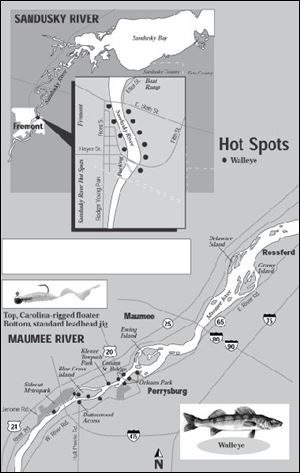
Use smaller baits for sure spring walleye
3/25/2005
The annual spring walleye spawning runs on the Maumee and Sandusky rivers are improving after a slow start, and if you want to improve your catch-rate, think small.
That is the top advice of river-run veterans such as Gary Lowry, proprietor of Maumee Valley Bait and Tackle in Maumee. Use small baits and work them slow, he advises.
By small, he means a 1/8 to 3/8 ounce leadhead jig dressed with a two to three-inch plastic grubtail, or a floating jighead and tail, Carolina-rigged, using an egg sinker. Use just enough weight so that you can occasionally feel it tick the bottom.
Reliable colors include white, chartreuse, bright pink, and two-color combinations.
Lowry has promoted Carolina-rigged floaters in recent years, continually encouraging anglers to try it.
The increasing popularity of the rig is proof that it works.
He uses leaders of 18 to 24 inches behind a barrel swivel and egg sinker. A photo accompanying this article illustrates the Carolina rig, and a full discussion of the rig and other river tackle can be seen on the shop Web site, www.maumeetackle.net, under fishing techniques.
When Lowry uses traditional leadheads and needs more weight because of heavier current or because he is fishing a deeper run, he will pinch on a split-shot or two about 15 inches above the jig, rather than switch to a heavier jig.
In the case of either leadhead jig or Carolina floater rig, if you are snagging bottom too often, go lighter. If you never feel bottom, add weight.
A six-foot medium to medium-heavy spinning rod and 8-to 10-pound line is a standard, though some successful anglers use ultralights, 4-pound-test line, and teeny jigs. Others prefer baitcasting gear.
Another important Lowry tip: It s a light bite and you need to pay attention. That means concentrating on the drifting line and watching the rod tip, which will dip lower when a fish takes the bait.
Direct your casts slightly upstream, so that the bait will drift to the bottom directly in front of you. Then just let it drift downstream, reeling up any slack and following it with your rod-tip.
When in doubt set the hook, Lowry notes.
River temperatures during the spring run are 40 to 50 degrees, plenty cold enough to develop potentially deadly, body-numbing hypothermia.
The Ohio Division of Watercraft recommends wearing a life jacket or floatation coat, whether in a small boat or wading. Dress in layers for the weather. Bring extra clothes. In short, be prepared.
Buy and wear the best chest waders you can afford. Cinch a belt snugly around the waist to prevent filling your waders if you fall in.
Carry a wading stick or staff. A pair of crampons or metal cleats, which fit over the wader boots, can improve traction on slippery bottom areas.
Be sure, too, that someone knows where you have gone and when you expect to return.
Maps accompanying this article show the most popular fishing stretches.
Remember, too, that walleye can run as far up the Maumee
as the Grand Rapids Dam. So some upstream sites may produce
fish, minus the crowds of eager anglers. Among places to try upstream are around the State Rt. 64 Bridge at Waterville, and the Miltonville and Van Tassel Public Access sites on State Rt. 65, and Otsego Park on Route 65 at State Rt. 235.
For updates on fishing conditions, check the Maumee Valley Bait and Tackle Web site above, or call the shop, 419-893-FISH. Another reliable bait shop is River Lures at Grand Rapids, operated by Chris
Martin, 419-832-0989. In Fremont call Anglers Supply, 419-332-6071. The Ohio Division of Wildlife toll-free fishing report is available at 1-888-HOOKFISH, and the Side Cut Metropark fishing report is available at 419-407-9731, option 1. The latter is a new number this year. Ohio Wildlife District 2 at Findlay can be reached at 419-424-5000.
Remember to obtain your new fishing license, that the daily creel limit is three walleye for March and April, that only a single hook is allowed in the special river zones and in Maumee and Sandusky bays until May 1, and that the minimum keeper length for walleye
is 15 inches.
Fishing in the special river zones is allowed only sunrise to
sunset until May 1. All snagged fish, that is, any fish not hooked
inside the mouth, must be released immediately. A full rundown on the fishing regulations is available at the state Web site, www.ohiodnr.com, or in the free pamphlet, digest of 2005-2006 Ohio Fishing Regulations, available wherever licenses are sold.
The runs on both rivers slowly have been cranking up as water temperatures move into the magic 40 to 50-degree range. Each successive warm rain, should bring up additional fish. The peaks of the runs still are expected during the first two weeks of April.
Only some 2003 fish, in the 12 to 16-inch range, are expected
because younger fish are not yet mature enough to spawn.
Fish from 2001 should be 17 to 20 inches, and those from 1999
about 20 to 24 inches. Some older trophy-size fish also are expected.
Last and certainly not least: Litter. Don t.
Take a plastic grocery sack with you in your pocket and pick up trash and spent fishing line on your way back to the truck. Few things leave such a lasting, negative public impression about anglers as litter.
Lots of ethical fishermen already are picking it up. Good idea.
Contact Steve Pollick at: spollick@theblade.com or 419-724-6068.